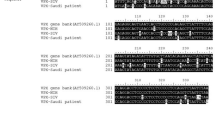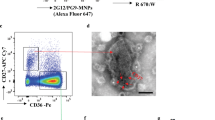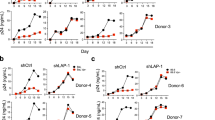Abstract
All primate lentiviruses (HIV-1, HIV-2, SIV) encode Nef proteins, which are important for viral replication and pathogenicity in vivo1,2,3. It is not known how Nef regulates these processes. It has been suggested that Nef protects infected cells from apoptosis and recognition by cytotoxic T lymphocytes4,5,6. Other studies suggest that Nef influences the activation state of the infected cell, thereby enhancing the ability of that cell to support viral replication7,8,9,10. Here we show that macrophages that express Nef or are stimulated through the CD40 receptor release a paracrine factor that renders T lymphocytes permissive to HIV-1 infection. This activity requires the upregulation of B-cell receptors involved in the alternative pathway of T-lymphocyte stimulation. T lymphocytes stimulated through this pathway become susceptible to viral infection without progressing through the cell cycle. We identify two proteins, soluble CD23 and soluble ICAM, that are induced from macrophages by Nef and CD40L, and which mediate their effects on lymphocyte permissivity. Our results reveal a mechanism by which Nef expands the cellular reservoir of HIV-1 by permitting the infection of resting T lymphocytes.
This is a preview of subscription content, access via your institution
Access options
Subscribe to this journal
Receive 51 print issues and online access
$199.00 per year
only $3.90 per issue
Buy this article
- Purchase on Springer Link
- Instant access to full article PDF
Prices may be subject to local taxes which are calculated during checkout





Similar content being viewed by others
References
Kirchhoff, F., Greenough, T. C., Brettler, D. B., Sullivan, J. L. & Desrosiers, R. C. Brief report: absence of intact nef sequences in a long-term survivor with nonprogressive HIV-1 infection. N. Engl. J. Med. 332, 228–232 (1995)
Deacon, N. J. et al. Genomic structure of an attenuated quasi species of HIV-1 from a blood transfusion donor and recipients. Science 270, 988–991 (1995)
Kestler, H. W. et al. Importance of the nef gene for maintenance of high virus loads and for development of AIDS. Cell 65, 651–662 (1991)
Johnson, W. E. & Desrosiers, R. C. Viral persistence: HIV's strategies of immune system evasion. Annu. Rev. Med. 53, 499–518 (2002)
Collins, K. L. & Baltimore, D. HIV's evasion of the cellular immune response. Immunol. Rev. 168, 65–74 (1999)
Geleziunas, R., Xu, W., Takeda, K., Ichijo, H. & Greene, W. C. HIV-1 Nef inhibits ASK1-dependent death signalling providing a potential mechanism for protecting the infected host cell. Nature 410, 834–838 (2001)
Saksela, K., Cheng, G. & Baltimore, D. Proline-rich (PxxP) motifs in HIV-1 Nef bind to SH3 domains of a subset of Src kinases and are required for the enhanced growth of Nef + viruses but not for down-regulation of CD4. EMBO J. 14, 484–491 (1995)
Fackler, O. T., Luo, W., Geyer, M., Alberts, A. S. & Peterlin, B. M. Activation of Vav by Nef induces cytoskeletal rearrangements and downstream effector functions. Mol. Cell 3, 729–739 (1999)
Fackler, O. T. & Baur, A. S. Live and let die: Nef functions beyond HIV replication. Immunity 16, 493–497 (2002)
Simmons, A., Aluvihare, V. & McMichael, A. Nef triggers a transcriptional program in T cells imitating single-signal T cell activation and inducing HIV virulence mediators. Immunity 14, 763–777 (2001)
Swingler, S. et al. HIV-1 Nef mediates lymphocyte chemotaxis and activation by infected macrophages. Nature Med. 5, 997–1003 (1999)
van Kooten, C. & Banchereau, J. CD40–CD40 ligand. J. Leukoc. Biol. 67, 2–17 (2000)
Wang, C. Y., Cusack, J. C. Jr, Liu, R. & Baldwin, A. S. Jr Control of inducible chemoresistance: enhanced anti-tumor therapy through increased apoptosis by inhibition of NF-kappaB. Nature Med. 5, 412–417 (1999)
Jamieson, B. D. & Zack, J. A. In vivo pathogenesis of human immunodeficiency Virus Type 1 reporter virus. J. Virol. 72, 6520–6526 (1998)
Chambers, C. A. The expanding world of co-stimulation: the two-signal model revisited. Trends Immunol. 22, 217–223 (2001)
Frauwirth, K. A. & Thompson, C. B. Activation and inhibition of lymphocytes by costimulation. J. Clin. Invest. 109, 295–299 (2002)
Gruber, M. F., Weih, K. A., Boone, E. J., Smith, P. D. & Clouse, K. A. Endogenous macrophage CSF production is associated with viral replication in HIV-1-infected human monocyte-derived macrophages. J. Immunol. 154, 5528–5535 (1995)
Eckstein, D. A. et al. HIV-1 Vpr enhances viral burden by facilitating infection of tissue macrophages but not nondividing CD4+ T cells. J. Exp. Med. 194, 1407–1419 (2001)
Lisignoli, G. et al. In vitro cultured stromal cells from human tonsils display a distinct phenotype and induce B cell adhesion and proliferation. Eur. J. Immunol. 26, 17–27 (1996)
Stevenson, M., Stanwick, T. L., Dempsey, M. P. & Lamonica, C. A. HIV-1 replication is controlled at the level of T cell activation and proviral integration. EMBO J. 9, 1551–1560 (1990)
Zack, J. A. et al. HIV-1 entry into quiescent primary lymphocytes: molecular analysis reveals a labile, latent viral structure. Cell 61, 213–222 (1990)
Pierson, T. C. et al. Molecular characterization of preintegration latency in human immunodeficiency virus type 1 infection. J. Virol. 76, 8518–8531 (2002)
Wu, Y. & Marsh, J. W. Selective transcription and modulation of resting T cell activity by preintegrated HIV DNA. Science 293, 1503–1506 (2001)
Geyer, M., Fackler, O. T. & Peterlin, B. M. Structure–function relationships in HIV-1 Nef. EMBO Rep. 2, 580–585 (2001)
Greene, W. C. & Peterlin, B. M. Charting HIV's remarkable voyage through the cell: Basic science as a passport to future therapy. Nature Med. 8, 673–680 (2002)
Davis, S. J. & van der Merwe, P. A. CD2: an exception to the immunoglobulin superfamily concept? Science 273, 1241–1242 (1996)
Zhang, Z. et al. Sexual transmission and propagation of SIV and HIV in resting and activated CD4+ T cells. Science 286, 1353–1357 (1999)
Kalter, D. C. et al. Enhanced HIV replication in macrophage colony-stimulating factor-treated monocytes. J. Immunol. 146, 298–306 (1991)
Acknowledgements
We thank A. Dauphin, and K. Triques for research support, B. Blais for FACS analysis, B. Mellor for preparation of the figures, and T. Pinkos and N. Nelson for manuscript preparation. We also wish to acknowledge assay support provided by the University of Massachusetts Center for AIDS Research. The recombinant IκBα expression plasmid was kindly provided by R. Gaynor; the IκBαSR and LacZ adenovirus vectors were kindly provided by A. Baldwin. HIV-1SFI and HIV-1HSA were obtained through the AIDS Research and Reference Reagent Program, Division of AIDS, NIAID, NIH. This study was supported by grants from the NIH and the Jenner Foundation to M.S.
Author information
Authors and Affiliations
Corresponding author
Ethics declarations
Competing interests
The authors declare that they have no competing financial interests.
Rights and permissions
About this article
Cite this article
Swingler, S., Brichacek, B., Jacque, JM. et al. HIV-1 Nef intersects the macrophage CD40L signalling pathway to promote resting-cell infection. Nature 424, 213–219 (2003). https://doi.org/10.1038/nature01749
Received:
Accepted:
Issue Date:
DOI: https://doi.org/10.1038/nature01749
This article is cited by
-
Protein N-myristoylation: functions and mechanisms in control of innate immunity
Cellular & Molecular Immunology (2021)
-
Increased Plasma Levels of the TH2 chemokine CCL18 associated with low CD4+ T cell counts in HIV-1-infected Patients with a Suppressed Viral Load
Scientific Reports (2019)
-
HIV-1 Nef CAWLEAQ motif: a regulator of monocytes invasion through ENO1 modulation
Molecular and Cellular Biochemistry (2018)
-
The macrophage: a therapeutic target in HIV-1 infection
Molecular and Cellular Therapies (2014)
-
B cell lymphoma in hiv transgenic mice
Retrovirology (2013)
Comments
By submitting a comment you agree to abide by our Terms and Community Guidelines. If you find something abusive or that does not comply with our terms or guidelines please flag it as inappropriate.



